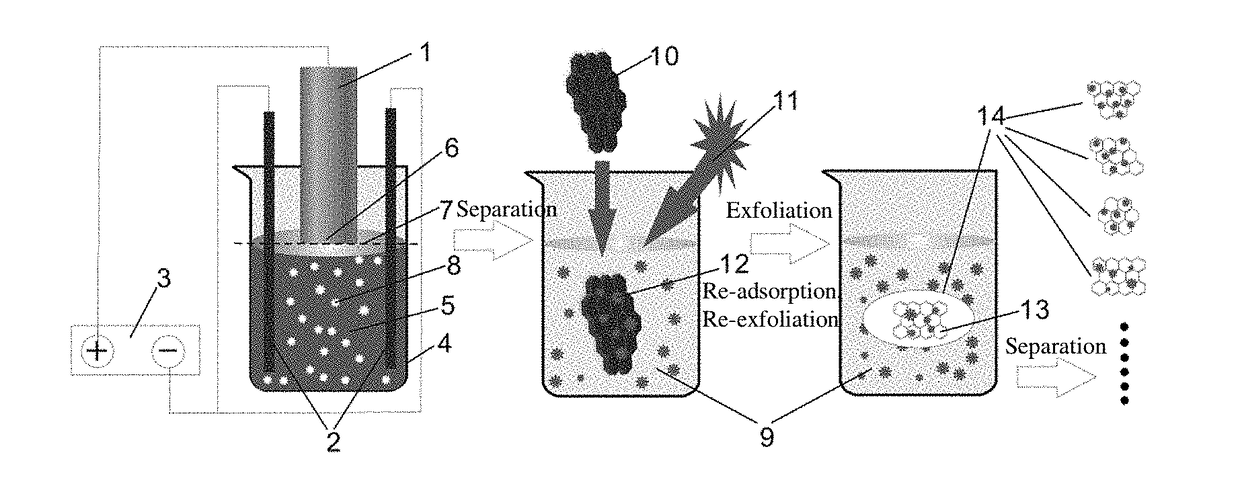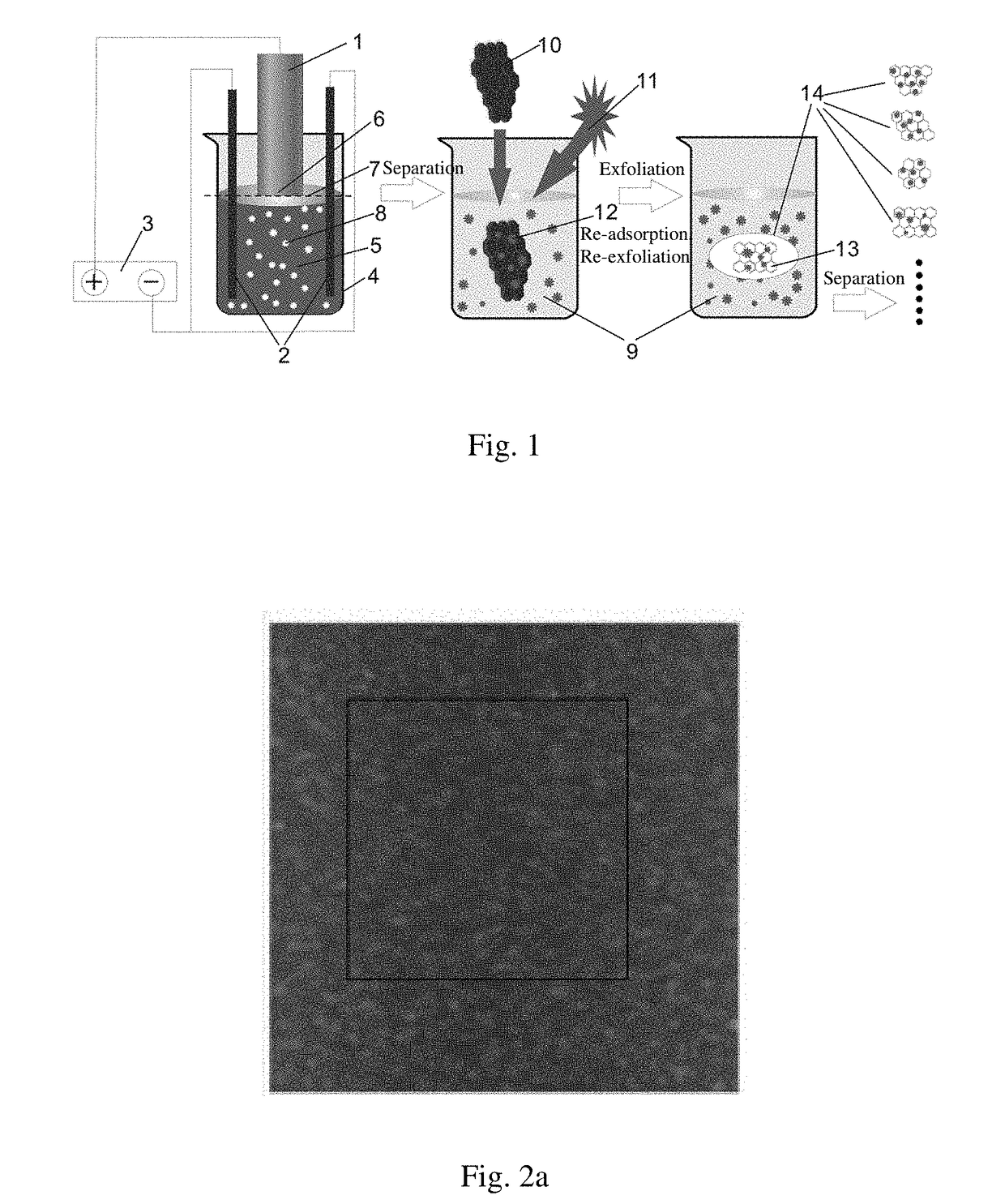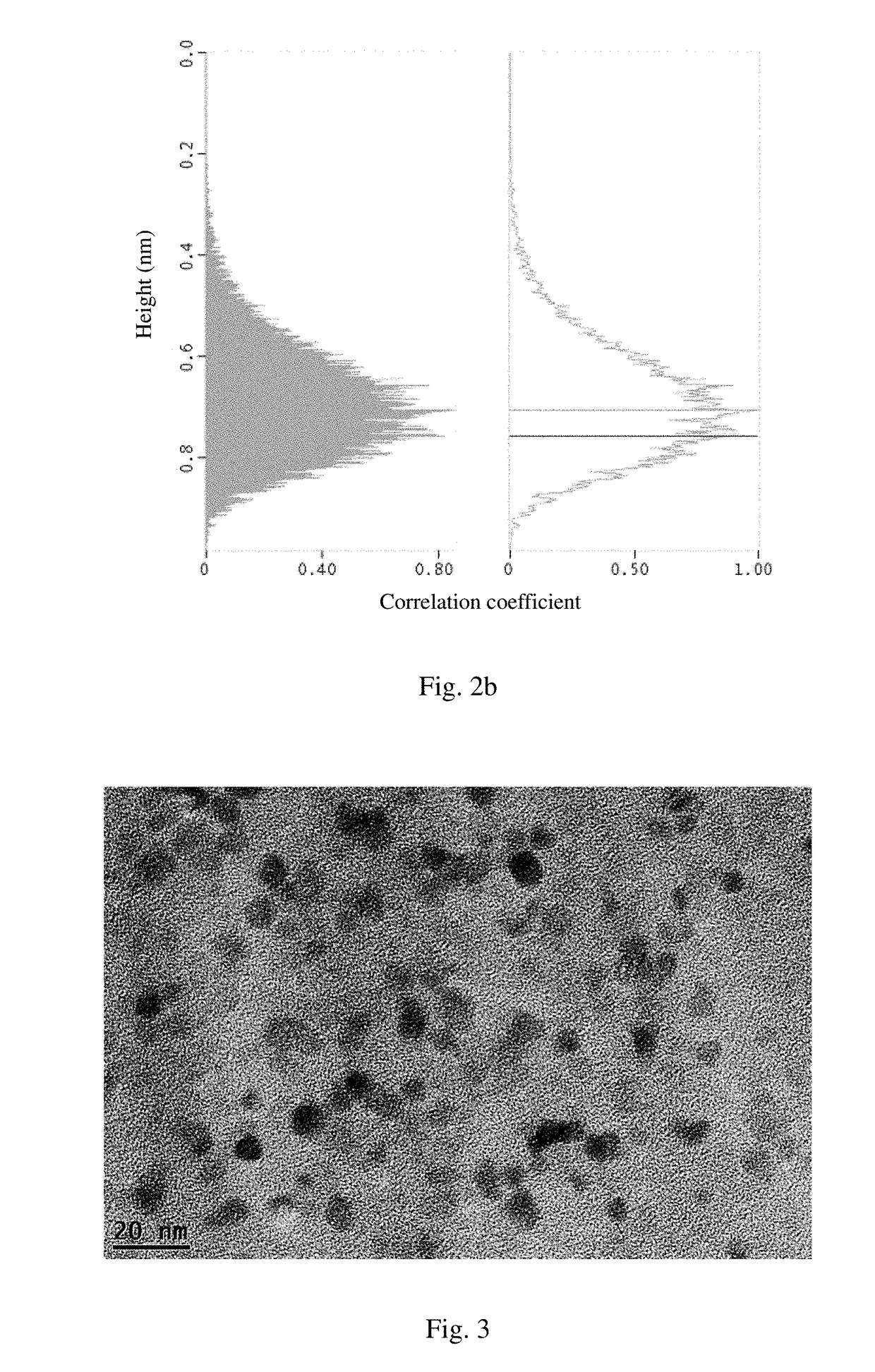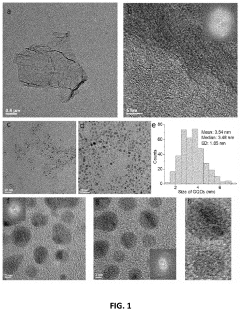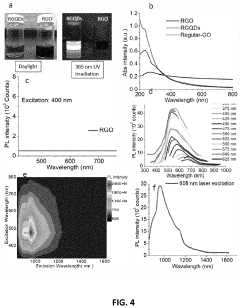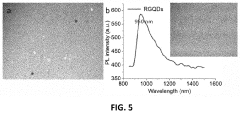Graphene Oxide in Quantum Dots: Illuminating Future Possibilities
Graphene Oxide QDs: Evolution and Objectives
Graphene oxide quantum dots (GOQDs) have emerged as a groundbreaking nanomaterial, combining the exceptional properties of graphene with the unique characteristics of quantum dots. The evolution of this technology can be traced back to the discovery of graphene in 2004, which sparked a revolution in materials science. As researchers explored the potential of graphene, they soon realized that by reducing its size to nanoscale dimensions, they could unlock even more remarkable properties.
The development of GOQDs began in earnest in the early 2010s, as scientists sought to harness the quantum confinement effects in graphene-based materials. This led to the creation of graphene quantum dots, which exhibited strong photoluminescence and excellent biocompatibility. However, the hydrophobic nature of pristine graphene limited its applications in biological and aqueous systems.
To overcome this challenge, researchers turned their attention to graphene oxide, a functionalized form of graphene with oxygen-containing groups. The incorporation of oxygen not only improved water solubility but also introduced new electronic and optical properties. This breakthrough paved the way for the development of graphene oxide quantum dots, which combined the advantages of both graphene and quantum dots.
The objectives of research in GOQDs have evolved significantly over the past decade. Initially, the focus was on synthesizing and characterizing these novel nanomaterials. As understanding grew, attention shifted towards optimizing their properties for specific applications. Current research aims to exploit the unique features of GOQDs, such as their tunable photoluminescence, high quantum yield, and excellent electron transfer capabilities.
One of the primary goals in GOQD research is to develop more efficient and scalable synthesis methods. This includes exploring green synthesis routes and improving the control over size, shape, and surface functionalization. Another critical objective is to enhance the optical properties of GOQDs, particularly their quantum yield and emission wavelength tunability, to expand their potential in optoelectronic and biomedical applications.
Researchers are also focusing on understanding and manipulating the electronic structure of GOQDs to tailor their properties for specific uses. This includes investigating ways to control the band gap and engineer the density of states, which could lead to breakthroughs in areas such as photocatalysis and energy conversion.
As the field progresses, there is a growing emphasis on translating laboratory discoveries into practical applications. This involves addressing challenges related to large-scale production, stability, and integration into existing technologies. The ultimate goal is to harness the full potential of GOQDs in areas such as bioimaging, drug delivery, sensors, and energy storage, paving the way for next-generation technologies that could revolutionize multiple industries.
Market Demand Analysis for GO-QD Applications
The market demand for Graphene Oxide Quantum Dots (GO-QDs) applications is experiencing significant growth, driven by their unique properties and versatile potential across various industries. The global quantum dot market, which includes GO-QDs, is projected to expand rapidly in the coming years, with a compound annual growth rate (CAGR) exceeding 20% through 2025.
In the biomedical field, GO-QDs are gaining traction for their applications in bioimaging, drug delivery, and biosensing. The increasing prevalence of chronic diseases and the need for more precise diagnostic tools are fueling the demand for GO-QD-based solutions. Hospitals and research institutions are showing keen interest in adopting these advanced materials for improved medical imaging and targeted therapies.
The electronics industry represents another major market for GO-QDs, particularly in display technologies. As consumers demand higher quality screens with better color reproduction and energy efficiency, manufacturers are turning to quantum dot technology. GO-QDs offer advantages over traditional quantum dots, including enhanced stability and easier processability, making them attractive for next-generation displays in smartphones, televisions, and other electronic devices.
Environmental applications of GO-QDs are also emerging as a significant market segment. The growing concern over water pollution and the need for efficient water treatment solutions are driving the demand for GO-QD-based sensors and purification systems. Industries and municipalities are exploring these materials for their potential in detecting and removing contaminants from water sources.
In the energy sector, GO-QDs are showing promise in solar cell applications. The push for renewable energy sources and the continuous effort to improve solar cell efficiency are creating opportunities for GO-QD integration in photovoltaic technologies. Research institutions and solar panel manufacturers are investing in developing GO-QD-enhanced solar cells to achieve higher conversion rates and lower production costs.
The optoelectronics market is another area where GO-QDs are gaining attention. Their unique optical properties make them suitable for applications in light-emitting diodes (LEDs), photodetectors, and optical sensors. As the demand for more efficient and sensitive optoelectronic devices grows across industries such as telecommunications, automotive, and consumer electronics, the market for GO-QD-based solutions is expected to expand.
While the market potential for GO-QDs is substantial, challenges such as high production costs and the need for scalable manufacturing processes remain. However, ongoing research and development efforts are addressing these issues, potentially leading to wider adoption and market penetration in the near future.
Current Challenges in GO-QD Synthesis and Performance
The synthesis and performance optimization of graphene oxide quantum dots (GO-QDs) present several significant challenges that researchers and industry professionals are actively addressing. One of the primary hurdles is achieving consistent and scalable production methods. Current synthesis techniques often result in heterogeneous size distributions and varying optical properties, which can significantly impact the performance and applicability of GO-QDs in various fields.
Control over the size and shape of GO-QDs remains a critical challenge. The quantum confinement effect, which is responsible for the unique optical and electronic properties of these nanostructures, is highly dependent on their dimensions. Achieving precise control over these parameters during synthesis is crucial for tailoring GO-QDs to specific applications, yet it remains difficult to consistently produce uniform particles.
The surface chemistry of GO-QDs poses another significant challenge. The presence of oxygen-containing functional groups on the surface of graphene oxide can lead to unpredictable interactions with the surrounding environment, affecting stability and performance. Balancing the degree of oxidation to maintain desirable quantum dot properties while ensuring adequate solubility and reactivity is a delicate process that requires further refinement.
Photoluminescence efficiency is a key performance metric for GO-QDs, particularly in imaging and sensing applications. However, current synthesis methods often yield quantum dots with relatively low quantum yields compared to traditional semiconductor quantum dots. Enhancing the brightness and stability of GO-QD emission remains an active area of research, with efforts focused on surface passivation and doping strategies.
The integration of GO-QDs into practical devices and systems presents its own set of challenges. Issues such as aggregation, photobleaching, and non-specific binding can limit the effectiveness of GO-QDs in real-world applications. Developing robust methods for incorporating these nanostructures into various matrices while maintaining their unique properties is crucial for advancing their practical use.
Toxicity and biocompatibility concerns also pose challenges, particularly for biomedical applications. While GO-QDs are generally considered less toxic than heavy metal-based quantum dots, comprehensive long-term studies on their biological effects are still needed. Ensuring the safety of GO-QDs for in vivo applications while maintaining their functionality is a complex balancing act that requires ongoing research and development.
Lastly, the scalability of GO-QD production remains a significant hurdle for widespread industrial adoption. Current laboratory-scale synthesis methods often struggle to maintain consistency and quality when scaled up to industrial levels. Developing economically viable, large-scale production techniques that can deliver high-quality GO-QDs with reproducible properties is essential for realizing their full potential across various technological domains.
Existing GO-QD Synthesis and Functionalization Methods
01 Synthesis and preparation of graphene oxide quantum dots
Various methods for synthesizing and preparing graphene oxide quantum dots are described. These techniques involve chemical, electrochemical, or physical processes to produce quantum dots with specific properties suitable for illumination applications. The methods aim to control the size, shape, and surface functionalization of the quantum dots to enhance their optical properties.- Synthesis and properties of graphene oxide quantum dots: Methods for synthesizing graphene oxide quantum dots with specific optical and electronic properties. These quantum dots exhibit unique illumination characteristics due to their size-dependent bandgap and can be used in various applications such as bioimaging, sensing, and optoelectronic devices.
- Surface functionalization of graphene oxide quantum dots: Techniques for modifying the surface of graphene oxide quantum dots to enhance their properties or tailor them for specific applications. This can include attaching functional groups or molecules to improve solubility, biocompatibility, or targeting capabilities for use in biological systems or advanced materials.
- Applications in bioimaging and biosensing: Utilization of graphene oxide quantum dots for biological imaging and sensing applications. Their unique optical properties, low toxicity, and ability to be functionalized make them ideal for cellular imaging, drug delivery monitoring, and detection of biomolecules or environmental pollutants.
- Integration into optoelectronic devices: Incorporation of graphene oxide quantum dots into various optoelectronic devices such as light-emitting diodes, solar cells, and photodetectors. Their tunable bandgap and high electron mobility contribute to improved device performance and efficiency.
- Large-scale production and purification methods: Development of scalable production techniques and purification methods for graphene oxide quantum dots. These processes aim to produce high-quality quantum dots in large quantities while maintaining consistent size distribution and optical properties, which is crucial for their commercial application in illumination and other fields.
02 Optical properties and luminescence mechanisms
The optical properties and luminescence mechanisms of graphene oxide quantum dots are explored. These nanostructures exhibit unique photoluminescence characteristics, which can be tuned by controlling their size, shape, and surface chemistry. The quantum confinement effect and surface states play crucial roles in determining the emission wavelengths and quantum yields of the dots.Expand Specific Solutions03 Applications in lighting and displays
Graphene oxide quantum dots are utilized in various lighting and display applications. Their high brightness, color purity, and stability make them suitable for use in LED lighting, OLED displays, and other illumination devices. The integration of these quantum dots into existing technologies can lead to improved energy efficiency and color rendering.Expand Specific Solutions04 Functionalization and composite materials
Methods for functionalizing graphene oxide quantum dots and incorporating them into composite materials are described. These processes aim to enhance the dots' compatibility with various matrices, improve their stability, and tailor their properties for specific applications. Functionalization can also lead to the development of novel hybrid materials with unique optical and electronic properties.Expand Specific Solutions05 Biomedical and sensing applications
Graphene oxide quantum dots are explored for their potential in biomedical imaging and sensing applications. Their low toxicity, high photostability, and tunable optical properties make them suitable for bioimaging, drug delivery, and biosensing. The development of these applications focuses on improving sensitivity, selectivity, and biocompatibility of the quantum dot-based systems.Expand Specific Solutions
Key Players in Graphene Oxide and Quantum Dot Industry
The field of graphene oxide in quantum dots is in a dynamic growth phase, with significant market potential due to its diverse applications in optoelectronics, biosensing, and energy storage. The global market for quantum dots is expanding rapidly, driven by increasing demand for advanced display technologies and biomedical imaging. While the technology is still evolving, several key players are making substantial progress. Universities like William Marsh Rice University, Korea Advanced Institute of Science & Technology, and Nanyang Technological University are at the forefront of research, while companies such as Corning, Inc. and TCL China Star Optoelectronics Technology Co., Ltd. are working on commercial applications. The involvement of research institutions like Centre National de la Recherche Scientifique and industry players indicates a maturing technology landscape, with potential for breakthrough innovations in the near future.
William Marsh Rice University
Korea Advanced Institute of Science & Technology
Breakthrough Research in GO-QD Properties and Applications
- A method involving electrochemical oxidation of a carbon-based 3D bulk material under controlled conditions to produce GOQDs, which are then used to form a composite nanomaterial with graphene or graphene-like structures, maintaining the integrity of the 2D structure and preventing refolding, through a process of exfoliation and re-exfoliation under mechanical shear force.
- Graphene quantum dots that emit in the near-infrared region in response to various excitation wavelengths, synthesized via top-down or bottom-up methods, offering scalable production, high biocompatibility, and reduced autofluorescence, allowing for effective bioimaging and drug delivery with improved tissue penetration.
Environmental Impact and Sustainability of GO-QDs
The environmental impact and sustainability of graphene oxide quantum dots (GO-QDs) are critical considerations as this technology advances. While GO-QDs offer promising applications in various fields, their potential effects on ecosystems and human health require thorough examination.
GO-QDs' production process typically involves chemical reactions that may generate hazardous byproducts. The use of strong acids and oxidizing agents in graphene oxide synthesis can lead to environmental contamination if not properly managed. Additionally, the small size of quantum dots raises concerns about their potential to enter and accumulate in living organisms, potentially disrupting biological processes.
However, GO-QDs also present opportunities for environmental sustainability. Their unique properties enable applications in environmental sensing and remediation. For instance, GO-QDs can be used to detect and remove heavy metals from water, contributing to pollution control efforts. Their high sensitivity and selectivity make them valuable tools for monitoring environmental contaminants at low concentrations.
The lifecycle assessment of GO-QDs is an essential aspect of evaluating their sustainability. From raw material extraction to disposal, each stage must be scrutinized for its environmental impact. The energy-intensive nature of graphene production is a particular concern, as it contributes to the carbon footprint of GO-QDs. Developing more efficient and eco-friendly synthesis methods is crucial for improving the overall sustainability of this technology.
Recycling and safe disposal of GO-QDs present challenges due to their nanoscale size and complex composition. Research into effective recovery and reuse strategies is necessary to minimize waste and prevent potential environmental contamination. Additionally, the long-term effects of GO-QDs on ecosystems and biodegradation pathways require further investigation to ensure their safe use and disposal.
As the field progresses, it is imperative to establish comprehensive regulatory frameworks and guidelines for the production, use, and disposal of GO-QDs. These measures should address potential risks while fostering innovation and sustainable development. Collaboration between researchers, industry stakeholders, and policymakers is essential to strike a balance between technological advancement and environmental protection.
In conclusion, while GO-QDs offer significant potential for various applications, their environmental impact and sustainability must be carefully managed. Ongoing research and development should focus on minimizing negative effects while maximizing the benefits of this promising technology.
Intellectual Property Landscape in GO-QD Technology
The intellectual property landscape surrounding Graphene Oxide in Quantum Dots (GO-QD) technology is rapidly evolving, reflecting the growing interest and potential applications in this field. A comprehensive analysis of patent filings and scientific publications reveals several key trends and focal points of innovation.
Patent activity in the GO-QD domain has seen a significant uptick in recent years, with major research institutions and technology companies leading the charge. The majority of patents focus on synthesis methods, functionalization techniques, and novel applications of GO-QDs in various sectors, including electronics, biomedical imaging, and energy storage.
One prominent area of patent concentration is the development of more efficient and scalable production methods for GO-QDs. These patents often detail innovative approaches to controlling size, shape, and optical properties of the quantum dots, which are crucial for their performance in different applications.
Another significant cluster of patents revolves around the functionalization of GO-QDs, particularly for biomedical applications. These innovations aim to enhance biocompatibility, improve targeting capabilities, and optimize drug delivery efficiency.
In the energy sector, patents related to GO-QDs in photovoltaic cells and energy storage devices are gaining traction. These inventions typically focus on improving energy conversion efficiency and developing more durable and cost-effective materials.
Geographically, patent filings are concentrated in countries with strong research and development capabilities in nanotechnology, such as the United States, China, South Korea, and Japan. However, there is an increasing trend of collaborative international patents, indicating the global nature of GO-QD research.
The scientific literature landscape closely mirrors the patent trends, with a surge in publications exploring novel synthesis methods, characterization techniques, and potential applications of GO-QDs. Many of these publications serve as the foundation for subsequent patent filings, highlighting the close relationship between academic research and industrial innovation in this field.
Key players in the GO-QD intellectual property landscape include major technology corporations, leading universities, and specialized nanotechnology firms. These entities often hold broad patent portfolios covering multiple aspects of GO-QD technology, from fundamental synthesis methods to specific applications.
As the field continues to mature, it is likely that we will see an increase in patent litigation and licensing agreements, particularly in high-value application areas such as biomedical imaging and next-generation electronics. This underscores the importance of a robust intellectual property strategy for companies and institutions working in the GO-QD space.
